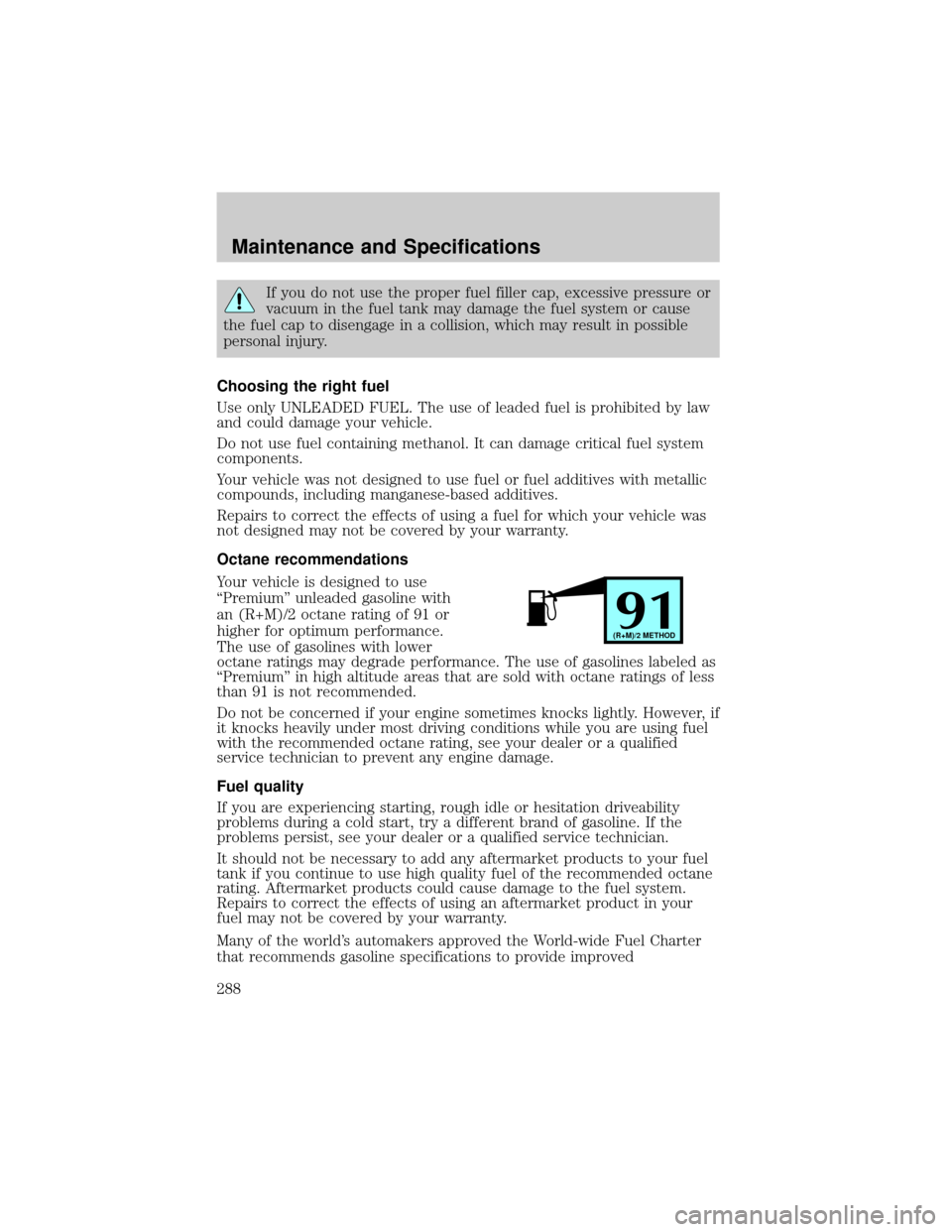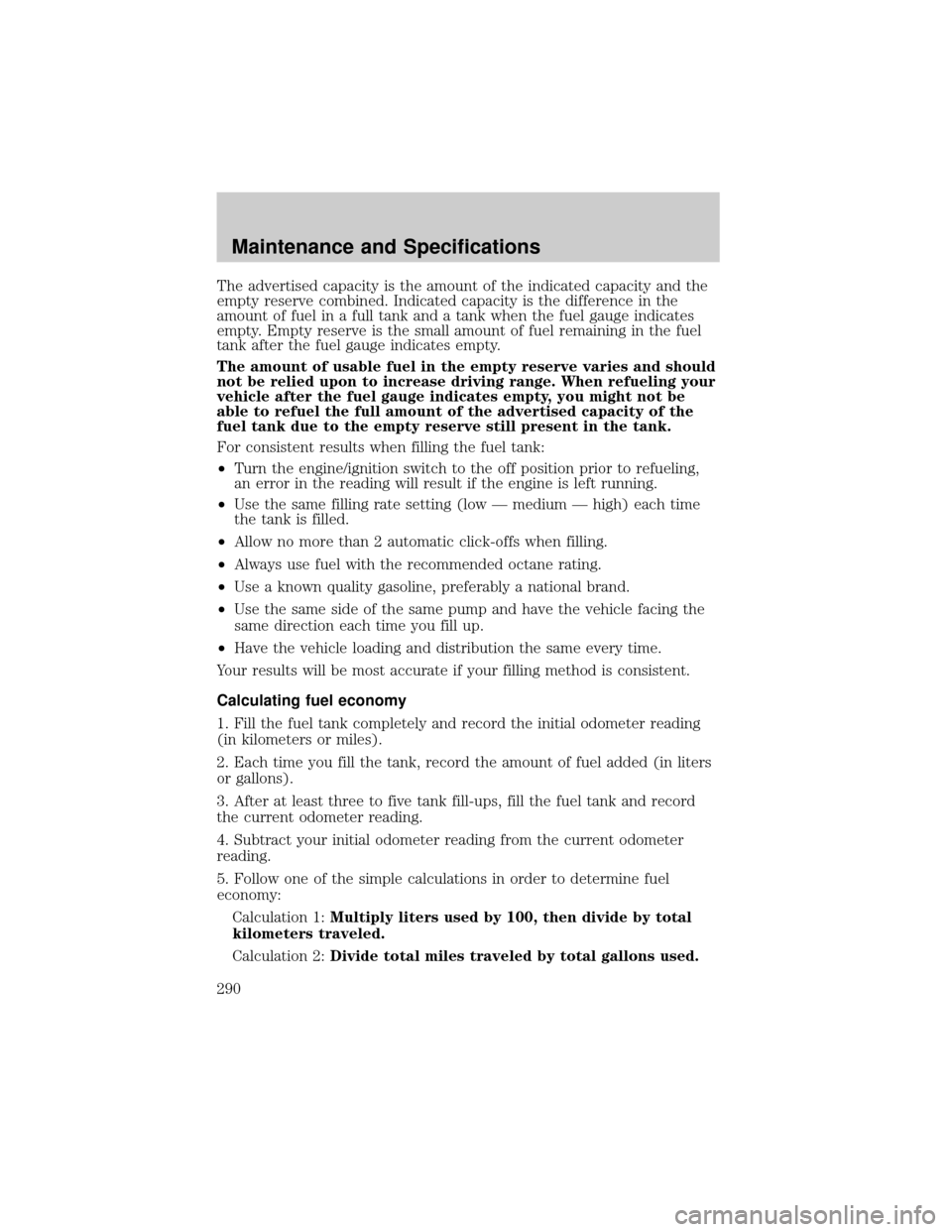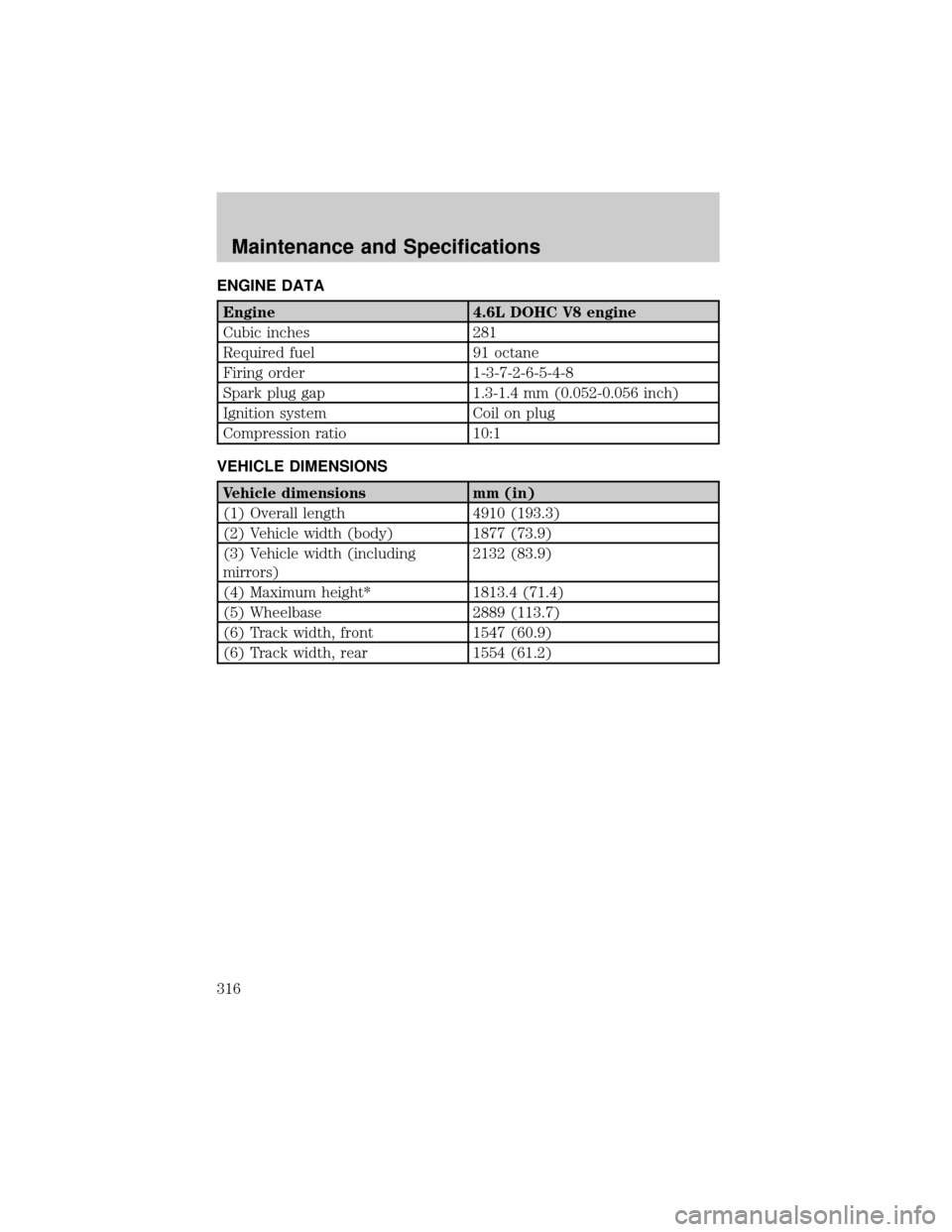octane LINCOLN AVIATOR 2004 Owners Manual
[x] Cancel search | Manufacturer: LINCOLN, Model Year: 2004, Model line: AVIATOR, Model: LINCOLN AVIATOR 2004Pages: 336, PDF Size: 3.69 MB
Page 288 of 336

If you do not use the proper fuel filler cap, excessive pressure or
vacuum in the fuel tank may damage the fuel system or cause
the fuel cap to disengage in a collision, which may result in possible
personal injury.
Choosing the right fuel
Use only UNLEADED FUEL. The use of leaded fuel is prohibited by law
and could damage your vehicle.
Do not use fuel containing methanol. It can damage critical fuel system
components.
Your vehicle was not designed to use fuel or fuel additives with metallic
compounds, including manganese-based additives.
Repairs to correct the effects of using a fuel for which your vehicle was
not designed may not be covered by your warranty.
Octane recommendations
Your vehicle is designed to use
ªPremiumº unleaded gasoline with
an (R+M)/2 octane rating of 91 or
higher for optimum performance.
The use of gasolines with lower
octane ratings may degrade performance. The use of gasolines labeled as
ªPremiumº in high altitude areas that are sold with octane ratings of less
than 91 is not recommended.
Do not be concerned if your engine sometimes knocks lightly. However, if
it knocks heavily under most driving conditions while you are using fuel
with the recommended octane rating, see your dealer or a qualified
service technician to prevent any engine damage.
Fuel quality
If you are experiencing starting, rough idle or hesitation driveability
problems during a cold start, try a different brand of gasoline. If the
problems persist, see your dealer or a qualified service technician.
It should not be necessary to add any aftermarket products to your fuel
tank if you continue to use high quality fuel of the recommended octane
rating. Aftermarket products could cause damage to the fuel system.
Repairs to correct the effects of using an aftermarket product in your
fuel may not be covered by your warranty.
Many of the world's automakers approved the World-wide Fuel Charter
that recommends gasoline specifications to provide improved
91(R+M)/2 METHOD
Maintenance and Specifications
288
Page 290 of 336

The advertised capacity is the amount of the indicated capacity and the
empty reserve combined. Indicated capacity is the difference in the
amount of fuel in a full tank and a tank when the fuel gauge indicates
empty. Empty reserve is the small amount of fuel remaining in the fuel
tank after the fuel gauge indicates empty.
The amount of usable fuel in the empty reserve varies and should
not be relied upon to increase driving range. When refueling your
vehicle after the fuel gauge indicates empty, you might not be
able to refuel the full amount of the advertised capacity of the
fuel tank due to the empty reserve still present in the tank.
For consistent results when filling the fuel tank:
²Turn the engine/ignition switch to the off position prior to refueling,
an error in the reading will result if the engine is left running.
²Use the same filling rate setting (low Ð medium Ð high) each time
the tank is filled.
²Allow no more than 2 automatic click-offs when filling.
²Always use fuel with the recommended octane rating.
²Use a known quality gasoline, preferably a national brand.
²Use the same side of the same pump and have the vehicle facing the
same direction each time you fill up.
²Have the vehicle loading and distribution the same every time.
Your results will be most accurate if your filling method is consistent.
Calculating fuel economy
1. Fill the fuel tank completely and record the initial odometer reading
(in kilometers or miles).
2. Each time you fill the tank, record the amount of fuel added (in liters
or gallons).
3. After at least three to five tank fill-ups, fill the fuel tank and record
the current odometer reading.
4. Subtract your initial odometer reading from the current odometer
reading.
5. Follow one of the simple calculations in order to determine fuel
economy:
Calculation 1:Multiply liters used by 100, then divide by total
kilometers traveled.
Calculation 2:Divide total miles traveled by total gallons used.
Maintenance and Specifications
290
Page 316 of 336

ENGINE DATA
Engine 4.6L DOHC V8 engine
Cubic inches 281
Required fuel 91 octane
Firing order 1-3-7-2-6-5-4-8
Spark plug gap 1.3-1.4 mm (0.052-0.056 inch)
Ignition system Coil on plug
Compression ratio 10:1
VEHICLE DIMENSIONS
Vehicle dimensions mm (in)
(1) Overall length 4910 (193.3)
(2) Vehicle width (body) 1877 (73.9)
(3) Vehicle width (including
mirrors)2132 (83.9)
(4) Maximum height* 1813.4 (71.4)
(5) Wheelbase 2889 (113.7)
(6) Track width, front 1547 (60.9)
(6) Track width, rear 1554 (61.2)
Maintenance and Specifications
316
Page 326 of 336

change oil soon warning,
message center .......................276
checking and adding ..............276
dipstick ....................................276
filter, specifications ........278, 311
recommendations ...................278
refill capacities ........................312
specifications ..................314, 316
Exhaust fumes ..........................196
F
Fail safe cooling ........................284
Floor mats .................................133
Fluid capacities .........................312
Foglamps .....................................82
Four-Wheel Drive vehicles
driving off road .......................213
preparing to drive your
vehicle .....................................203
Fuel ............................................285
calculating fuel
economy ..........................121, 289
cap ...........................................287
capacity ...................................312
choosing the right fuel ...........288
comparisons with EPA fuel
economy estimates .................292
detergent in fuel .....................289
filling your vehicle with
fuel ...........................285, 287, 289
filter, specifications ........289, 311
fuel pump shut-off switch .....232
improving fuel economy ........289
octane rating ...................288, 316
quality ......................................288
running out of fuel .................289
safety information relating to
automotive fuels .....................285
Fuses ..................................233±234G
Garage Door Opener (see
Homelink wireless control
system) ......................................114
Gas cap (see Fuel cap) ............287
Gas mileage
(see Fuel economy) .................289
Gauges .........................................14
GAWR (Gross Axle Weight
Rating)
calculating ...............................224
GVWR
(Gross Vehicle Weight Rating)
calculating ...............................224
H
Hazard flashers .........................232
Head restraints .........................153
Headlamps ...................................82
aiming ........................................85
autolamp system .......................82
bulb specifications ....................88
daytime running lights .............84
flash to pass ..............................85
high beam .................................84
replacing bulbs .........................90
turning on and off ....................82
HomeLink universal
transceiver
(see Garage door opener) .......118
Homelink wireless control
system ........................................114
I
Ignition ...............................193, 316
Index
326
Page 328 of 336

radio functions ..........................34
O
Octane rating ............................288
Oil (see Engine oil) ..................276
P
Panic alarm feature, remote
entry system ..............................139
Parking brake ............................198
Parts (see Motorcraft parts) ....311
Pedals (see Power adjustable
foot pedals) ...............................108
Power adjustable foot pedals ...108
Power distribution box
(see Fuses) ...............................238
Power door locks ......................136
Power mirrors ...........................106
Power point ...............................101
Power steering ..................202±203
fluid, checking and adding ....295
fluid, refill capacity ................312
fluid, specifications .........314, 316
Power Windows .........................102
Preparing to drive your
vehicle ........................................203
R
Radio ......................................16, 21
Rear Park Assist .......................209
Rear window defroster ...............81
Relays ................................233, 242
Remote entry system .......137, 139
illuminated entry ....................142locking/unlocking
doors ................................136, 138
opening the trunk ...................139
panic alarm .............................139
replacement/additional
transmitters .............................141
replacing the batteries ...........140
Roadside assistance ..................231
Roof rack ...................................134
S
Safety Belt Maintenance ..........173
Safety belts (see Safety
restraints) ..................165±167, 169
Safety Canopy ...........................179
Safety defects, reporting ..........265
Safety restraints ................165±169
belt minder .............................170
extension assembly ................173
for adults .........................166±167
for children .....................181±182
safety belt maintenance .........173
warning light and chime ........169
Safety seats for children ..........184
Seat belts
(see Safety restraints) .............165
Seats ..........................................153
child safety seats ....................184
climate control ........................157
easy access/easyout feature ..156
memory seat ...................139, 156
SecuriLock passive anti-theft
system ................................146±148
Servicing your vehicle ..............272
Snowplowing .................................7
Spark plugs,
specifications .....................311, 316
Index
328